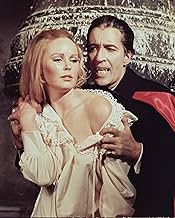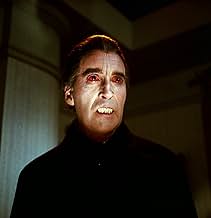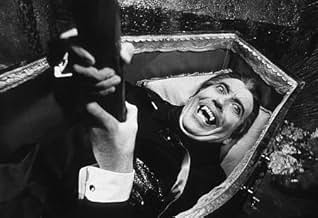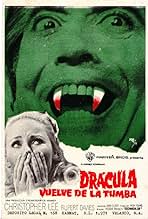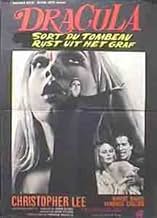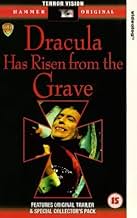IMDb-BEWERTUNG
6,5/10
8691
IHRE BEWERTUNG
Als Schloss Dracula vom Monsignore exorziert wird, bringt es den Grafen versehentlich von den Toten zurück.Als Schloss Dracula vom Monsignore exorziert wird, bringt es den Grafen versehentlich von den Toten zurück.Als Schloss Dracula vom Monsignore exorziert wird, bringt es den Grafen versehentlich von den Toten zurück.
- Regie
- Drehbuch
- Hauptbesetzung
- Auszeichnungen
- 1 Nominierung insgesamt
Christopher Cunningham
- Farmer
- (as Chris Cunningham)
Carrie Baker
- First victim
- (Nicht genannt)
Donald Campbell
- Tavern Customer
- (Nicht genannt)
Frank Forsyth
- Villager
- (Nicht genannt)
Lindsay Hooper
- Tavern Customer
- (Nicht genannt)
Philip Stewart
- Tavern Customer
- (Nicht genannt)
John Timberlake
- Tavern Customer
- (Nicht genannt)
Empfohlene Bewertungen
A weak script doesn't hinder "Dracula Has Risen from the Grave" from being absorbing most of the way. It has a weak mid-section full of repetitious scenes of Dracula about to take a bite out of a voluptuous female, scenes that don't advance the plot the way they should.
For this reason, some may find fault with the slow pace of much of the film but there's no denying the impressive look of sets, costumes and the proper Gothic atmosphere. Technicolor captures every bit of the shadows and light, just the way effective B&W photography has always done in the past. And the close-ups of Christopher Lee's bloodshot eyes lingers in the mind long after his infrequent appearance has been made.
That's also part of the problem. The role of Dracula really takes a back seat to others in the cast, all of whom are competent performers. Particularly engaging are Veronica Carlson (as one of Dracula's most sought after victims) and Barry Andrews as her infatuated boyfriend. Andrews plays the role of Paul with a saucy cockiness and a twinkle in his eye, easily making what is essentially a cardboard role a standout among the supporting players by virtue of his earnest performance and personality.
Engaging enough as a typical Dracula thriller, but clearly not the best of the Hammer films in this series. James Bernard's music helps keep the suspense level vibrant enough.
For this reason, some may find fault with the slow pace of much of the film but there's no denying the impressive look of sets, costumes and the proper Gothic atmosphere. Technicolor captures every bit of the shadows and light, just the way effective B&W photography has always done in the past. And the close-ups of Christopher Lee's bloodshot eyes lingers in the mind long after his infrequent appearance has been made.
That's also part of the problem. The role of Dracula really takes a back seat to others in the cast, all of whom are competent performers. Particularly engaging are Veronica Carlson (as one of Dracula's most sought after victims) and Barry Andrews as her infatuated boyfriend. Andrews plays the role of Paul with a saucy cockiness and a twinkle in his eye, easily making what is essentially a cardboard role a standout among the supporting players by virtue of his earnest performance and personality.
Engaging enough as a typical Dracula thriller, but clearly not the best of the Hammer films in this series. James Bernard's music helps keep the suspense level vibrant enough.
The folks at Hammer Film Productions were nothing if not passionate and professional. This entry into the legendary series is only an itty-bitty notch below their inaugural effort, the great "Horror Of Dracula,' as the second best of the entire series.
Chrisopher Lee is at his menacing best. No one can drive a horse-pulled hearse with his fierce intensity. And those eyes, YIKES! What a great effect, one that still gets me 35 years after i first saw the film as a 14-year old in Los Angeles' San Gabriel Valley (and where I saw it on TV not 15 minutes ago).
Hammer vets Freddie Francis and Anthony Hinds create killer-diller fun with strong atmosphere; eerie, colorful lighting and a solid story. And the acting is great, too. Hammer staff composer James Bernard's exciting score adds to the enjoyment.
Hammer's films are for kids ... kids like me who loved then as a teenager and kids like me who are now over 50.
Chrisopher Lee is at his menacing best. No one can drive a horse-pulled hearse with his fierce intensity. And those eyes, YIKES! What a great effect, one that still gets me 35 years after i first saw the film as a 14-year old in Los Angeles' San Gabriel Valley (and where I saw it on TV not 15 minutes ago).
Hammer vets Freddie Francis and Anthony Hinds create killer-diller fun with strong atmosphere; eerie, colorful lighting and a solid story. And the acting is great, too. Hammer staff composer James Bernard's exciting score adds to the enjoyment.
Hammer's films are for kids ... kids like me who loved then as a teenager and kids like me who are now over 50.
Great opening for this installment, a deaf altar boy discovers a young woman hanging upside down from the church bell, blood dripping from her neck. Move forward a year and Count Dracula is accidentally revived. He goes on his usual round of terror and bloodsucking, his target of desire being the beautiful Veronica Carlson. He certainly has great taste in women!
The sets are great, I felt like I was almost in the mountain village. Good cast, nice to see Hammer's most prolific actor Michael Ripper have a larger part than normal. No Peter Cushing here, which makes the vampire hunter aspect interesting. There is some debate within the film of faith versus atheism, apparently staking a vampire does not work if the person doing the staking lacks religious belief. Interesting.
We have no nudity but there are sexual overtones. Thankfully we get plenty of blood, plus Hammer's trademark day for night scenes and swirling fog.
Not one of the studio's best vampire movies but it's still a wonderful piece of Gothic horror, I grew up on watching these films and love immersing myself into them, over and over again.
Released in the USA in the Winter of 1969, Hammer's "Dracula has Risen from the Grave" was the fourth entry in the series and the third with Christopher Lee in the title role. Here's a list of the nine films for those interested:
Horror of Dracula (1958); The Brides of Dracula (1960); Dracula: Prince of Darkness (1966); Dracula Has Risen from the Grave (1968); Taste the Blood of Dracula (1969); Scars of Dracula (1970); Dracula AD 1972 (1972); The Satanic Rites of Dracula (1973); and The Legend of the 7 Golden Vampires (1974).
"Dracula has Risen from the Grave" suffers from a weak prologue and first act. The prologue takes place a year prior to the main story. The first act involves two priests hiking up to Dracula's castle to exorcise it. One of the priests unwittingly resurrects the count and the vampire wants revenge on the other priest whom he discovers blessed his abode. The final hour involves Dracula going after his niece in a neighboring village. The niece's boyfriend and the priest must defend her.
Like I said, the whole first act isn't very promising, but things perk up with the introduction of the niece's boyfriend, Paul, and the pub his dad runs. Barbara Ewing plays Zena, the redhead waitress at the pub, and the film shows the close relationships between Paul, his father and Zena. The characters ring true and it draws the viewer into their world. Excellent job on this front.
A great scene takes place when Paul's girlfriend, Maria (played by the stunning Veronica Carlson), takes Paul to her home to introduce him to her mother and the priest, who's a Monsignor (whatever that is). Paul is cornered in a conversation and forced to reveal that he doesn't believe in God. The Monsignor is initially offended and rude, but this can be excused on the grounds that he's the father-figure to his beloved niece; besides there's a warmhearted scene later in the film where the Monsignor proves his loving nature.
Another unusual highlight of the film are the multiple scenes that take place on the labyrinthian rooftops of the Victorian village. I can't help but wonder how they accomplished this. Were they really filming on the rooftops of a village or is it an illusion accomplished through matte paintings or other effects? I'm sure it's the latter; regardless, it's excellent film work and a unique feature of this film.
Of course, Hammer films are renown for their curvaceous women and here we have two: Redhead Barbara Ewing as the very likable Zena, and Veronica Carlson, who can also be seen in the outstanding "Frankenstein Must Be Destroyed".
As with most of Hammer's horror flicks, the movie possesses a beautifully lush, Gothic atmosphere.
Despite the weak first act, the positives noted above compel me place "Dracula has Risen from the Grave" as my second or third favorite of the series. My favorite being "Taste the Blood of Dracula."
The film runs 92 minutes and was shot at Pinewood Studios, Buckinghamshire, England.
GRADE: B
Horror of Dracula (1958); The Brides of Dracula (1960); Dracula: Prince of Darkness (1966); Dracula Has Risen from the Grave (1968); Taste the Blood of Dracula (1969); Scars of Dracula (1970); Dracula AD 1972 (1972); The Satanic Rites of Dracula (1973); and The Legend of the 7 Golden Vampires (1974).
"Dracula has Risen from the Grave" suffers from a weak prologue and first act. The prologue takes place a year prior to the main story. The first act involves two priests hiking up to Dracula's castle to exorcise it. One of the priests unwittingly resurrects the count and the vampire wants revenge on the other priest whom he discovers blessed his abode. The final hour involves Dracula going after his niece in a neighboring village. The niece's boyfriend and the priest must defend her.
Like I said, the whole first act isn't very promising, but things perk up with the introduction of the niece's boyfriend, Paul, and the pub his dad runs. Barbara Ewing plays Zena, the redhead waitress at the pub, and the film shows the close relationships between Paul, his father and Zena. The characters ring true and it draws the viewer into their world. Excellent job on this front.
A great scene takes place when Paul's girlfriend, Maria (played by the stunning Veronica Carlson), takes Paul to her home to introduce him to her mother and the priest, who's a Monsignor (whatever that is). Paul is cornered in a conversation and forced to reveal that he doesn't believe in God. The Monsignor is initially offended and rude, but this can be excused on the grounds that he's the father-figure to his beloved niece; besides there's a warmhearted scene later in the film where the Monsignor proves his loving nature.
Another unusual highlight of the film are the multiple scenes that take place on the labyrinthian rooftops of the Victorian village. I can't help but wonder how they accomplished this. Were they really filming on the rooftops of a village or is it an illusion accomplished through matte paintings or other effects? I'm sure it's the latter; regardless, it's excellent film work and a unique feature of this film.
Of course, Hammer films are renown for their curvaceous women and here we have two: Redhead Barbara Ewing as the very likable Zena, and Veronica Carlson, who can also be seen in the outstanding "Frankenstein Must Be Destroyed".
As with most of Hammer's horror flicks, the movie possesses a beautifully lush, Gothic atmosphere.
Despite the weak first act, the positives noted above compel me place "Dracula has Risen from the Grave" as my second or third favorite of the series. My favorite being "Taste the Blood of Dracula."
The film runs 92 minutes and was shot at Pinewood Studios, Buckinghamshire, England.
GRADE: B
When his castle is exorcised, Dracula (Christopher Lee) plots his revenge against the Monsignor (Rupert Davies) who performed the rites by attempting to make the holy man's young niece his bride.
This film is scandalous. Sure it passed the censors, and that is great, and Lee gives another great Dracula performance (with Davies as a more than adequate nemesis). But what we have here is an atheist in the home of a clergyman! Can you be an atheist and still believe in vampires?
Apparently, this was the most commercially successful of the Hammer Dracula films. I am not surprised, as it is quite entertaining. And with all due respect to Terence Fisher, I think I tend to prefer Freddie Francis' direction a little more. Francis knows his camera, and I think that adds something to his directing prowess.
This film is scandalous. Sure it passed the censors, and that is great, and Lee gives another great Dracula performance (with Davies as a more than adequate nemesis). But what we have here is an atheist in the home of a clergyman! Can you be an atheist and still believe in vampires?
Apparently, this was the most commercially successful of the Hammer Dracula films. I am not surprised, as it is quite entertaining. And with all due respect to Terence Fisher, I think I tend to prefer Freddie Francis' direction a little more. Francis knows his camera, and I think that adds something to his directing prowess.
Wusstest du schon
- WissenswertesThis was Hammer Films' most profitable movie.
- PatzerWhen the bell-ringer arrives at the church at the beginning of the movie he leaves his bicycle on the steps of the front door. When the priest arrives and rushes to investigate the screaming, the bicycle is no longer there.
- Alternative VersionenThe UK cinema version was cut by the BBFC to remove some closeup shots of Dracula pulling a stake from his heart. Later video and DVD releases were uncut.
- VerbindungenFeatured in Wie schmeckt das Blut von Dracula? (1970)
Top-Auswahl
Melde dich zum Bewerten an und greife auf die Watchlist für personalisierte Empfehlungen zu.
Details
- Erscheinungsdatum
- Herkunftsland
- Sprachen
- Auch bekannt als
- Drácula vuelve de la tumba
- Drehorte
- Produktionsfirma
- Weitere beteiligte Unternehmen bei IMDbPro anzeigen
- Laufzeit
- 1 Std. 32 Min.(92 min)
- Sound-Mix
- Seitenverhältnis
- 1.66 : 1(original/negative ratio)
Zu dieser Seite beitragen
Bearbeitung vorschlagen oder fehlenden Inhalt hinzufügen


